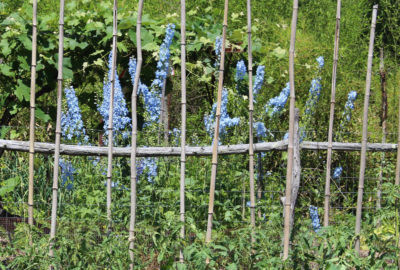OUT WITH THE OLD, IN WITH THE NEW
/4 Comments/in Fruit, Gardening/by Lee ReichIn Which I Emulate George Washington
It’s about 10 years since I planted the cherry tree, a sweet, self-pollinating variety called Stella, on dwarfing rootstock. During that time, the trunk swelled to about 7 inches in diameter and the branches shot skyward to 20 feet.
Stella is now gone, and it was all my doing. She took ten years to grow but only about an hour to cut down (with my new Stihl cordless electric chain saw, which I highly recommend). Afterlife of her trunk is as firewood, her branches as chipped mulch.
I warned Stella, who never bore one cherry, that this was her last chance. Finally, this spring she was loaded with blossoms, for the first time, followed by a good crop of developing cherries. A couple of weeks later, all the cherries were gone, except for two green ones I noticed on a cut branch. The weather could not have been at fault, nor birds at this early stage in the game. My guess is either an insect, probably plum curculio, or that the tree from the nursery was mislabeled, and it wasn’t Stella. Most varieties of sweet cherry need another variety nearby to set fruit.
She was pretty, but not pretty enough to grow as a strictly ornamental plant.
Oranges, Outdoors, In New York!
Waiting to replace Stella was a citrus(!) tree, a tree I could not have planted even a couple or years ago.
One reason I couldn’t have planted this tree is because it wasn’t a citrus tree back then. It’s a plant called hardy orange, previously assigned the genus and species Poncirus trifoliata. It’s always been a close relative of citrus, even used as a rootstock on which to graft commercial citrus trees. Only recently has it been fully welcomed into the fold and re-assigned the botanical name Citrus trifoliate. So previously I would have been planting a Poncirus but now I planted a Citrus. Same plant, different name.
The other reason I couldn’t have — or shouldn’t have — planted hardy orange under any name previously is because it’s only just barely winter hardy here. Winters of a few years ago were consistently colder and would have killed the plant down to the ground.
With stems cut back from cold, the plant would never have borne flowers, which have the look and delicious fragrance of other citrus flowers, or fruits, which look just like golfball-sized oranges. The flavor of the fruit is nothing to rave about, citrus-y yes, but also very sour, bitter, and not very juicy. Used with restraint, though, the fruits can be used for home-grown citrus flavoring.
The stems themselves, and their ominous thorns are hardy orange’s selling points here. The plant is evergreen, not because it holds onto its leaves through winter but because the stems are bright green year ‘round. My hardy orange is the variety Flying Dragon, whose twisting and turning stems are lined with ominously large, recurved — and also green — thorns.
Flying Dragon is a very interestingly attractive plant that can be used as flavoring, which is more that could have been said for my Stella.
Gumi Good
Except for Stella cherries, this year is shaping up to be an excellent year for fruits, even apples, plums, and other tree fruits, which are always chancy on my farmden, which is a naturally poor site for fruit growing.
Among many other fruits in the offing is a bumper crop of bright red, gold-flecked gumi fruits (Eleaegnus multiflora). The fruits followed sweet-smelling blossoms that perfumed the air earlier in the season and are an ornamental adjunct to the silvery leaves. Plus, the fruits have good flavor if picked thoroughly ripe.
The birds are having a field day with the gumis, so I only get to eat the fruits in their puckery stage when just that hint of good flavor can be detected in the background.
I’ve hung old CD’s among gumi’s branches, also among my mulberries’ branches, hoping the flashes of reflected light will scare birds away. It probably won’t because visual deterrents, when they are effective, are so mostly against flocking birds. The gumis are being enjoyed mostly by robins and catbirds.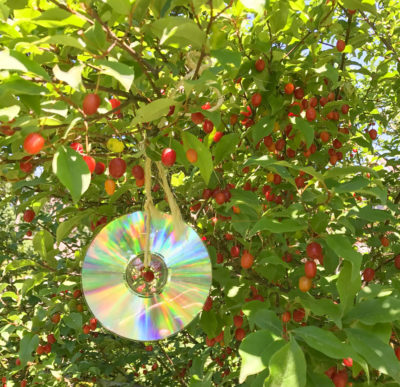
Let the birds have their fun. Black currants, which birds ignore, are also now ripe. And blueberries — my favorite — are ripening, and safe from birds enclosed in the netted “blueberry temple.”
THE GOOD OL’ DAYS
/1 Comment/in Fruit, Gardening, Pests, Planning, Vegetables/by Lee ReichCorn Made Even easier
I can understand why corn was so popular a crop early on in the settlement of our country by Europeans. Sure, it tastes good popped, ground and cooked, and, while immature, fresh from the cob. Mostly, though, corn was easy to grow in the rough soil left from recently cleared forest.
Most of my corn grows in my two vegetable gardens where the soil is crumbly and weed-free, watered gently by drip irrigation, and nourished annually with an inch depth of compost.

Highly cultivated sweet corn
The south garden is home, every year, to a couple of beds (about 60 square feet) of popcorn, and the north garden to 4 beds (about 215 square feet) of sweet corn. Those two gardens provide us with all the sweet corn and popcorn we eat for a year.
Separate gardens are needed because if sweet and popcorn cross-pollinate, the sweet corn will be less sweet and the popcorn won’t pop as well.
I also grow polenta corn, an heirloom Italian variety called Otto File. But I only have two vegetable gardens. So this corn goes out in the field into the weedy soil between my dwarf apple trees. Conditions there aren’t as rough as cornfields wrought from forests in colonial times, but out there the corn must deal with weeds, grasses, rabbits, and drink only water that falls from the sky.
I did not use colonial methods to ready the soil for planting. Instead, I mowed all vegetation to the ground, and covered the planting areas, 2 beds each about 3 feet wide for a total of about 100 square feet of planting, with gray resin paper. (Sometimes called building paper, gray resin paper is used in construction, usually as underlayment under flooring and siding.) I topped the paper with an inch or so of compost, then made two rows in each bed, in each row poking holes 2 feet apart into each of which I dropped 6 Otto File seeds followed by a sprinkling of water.
The seedlings are up and looking strong, so I thinned them out to 3 or 4 plants per hole, pulling out a few weeds as I thinned. I’ll weed one or two more times and then leave the plants to themselves. Weeds will grow, but the then-tall corn plants should shade some into submission and hold their own against the more aggressive ones.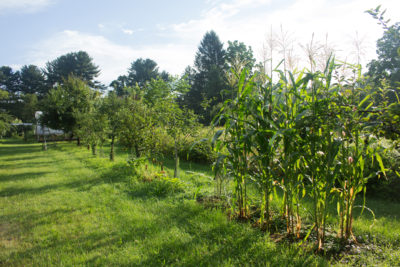
For authenticity, yes, I could have buried some fish in the ground at each planting hole. But that would be more work, and I’m interested in production with minimal effort from that planting. Each year those beds have provided a year’s supply of polenta corn.
Apple Threats
Apple trees flanking the Otto File beds are loaded with a hopeful crop of cherry-sized fruits. The dreaded plum curculio, which is as happy to ruin a crop of apples, peaches, nectarines, or cherries as well as plums, should have ceased their egg-laying by now, and burrowed into the soil to prepare for next year’s onslaught. (Surround® is an organically approved spray of specially formulated kaolin clay that controls curculios.)
Just because the nascent fruits have come along this far does not mean I’m home free. Apple maggot reliably makes its appearance just as the curculios vanish. This pest doesn’t usually make the fruit drop, as do curculios, but it riddles the fruit with so many tunnels that you can’t even eat around them.
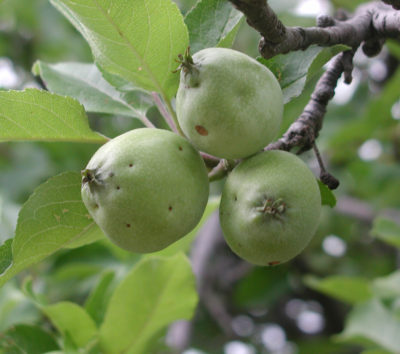
Maggot & curculio scars
Fortunately, non-chemical control of apple maggot is easy. In the 1980s, Dr. Ron Prokopy, at the University of Massachusetts, discovered that Ms. Maggot was attracted to the reddest apples, so he tried hanging croquet balls painted Tartarian Red and coated with forever-sticky Tangletrap® in apple trees. Maggots tried to lay eggs in the ersartz apples, where they expired, their mission unfulfilled. The spheres offer as good control as do chemical sprays.
In the last few years, I’ve used Tangletrap® coated, real Red Delicious apples as traps. They are very red and very apple-like. Hung in the branches, one per dwarf apple tree, they last almost the whole season and, when the season ends, can be composted rather than scraped clean for use the following year.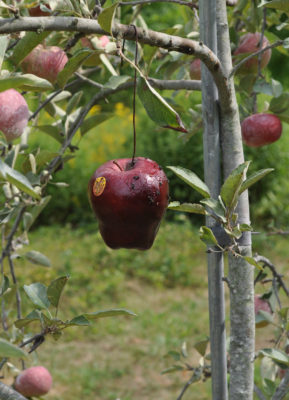
Apple maggot isn’t the only remaining threat to my apples. There’s also the codling moth (the classic worm in the apple), apple scab (that’s what it looks like), and various summer rots.
Once Upon A Time
Oh, for the good ol’ days when the grass was greener, the corn was sweeter, and apple trees took care of themselves. Mostly, the good ol’ days weren’t the various “-ers.” But one exception was the apple maggot. Two hundred years ago, Ms. Maggots didn’t look twice at apples. This native insect was happy to attack our native hawthorns, which are related to apples.
When apples were introduced to this part of the world, some apple maggot flies tried them out. Over time, some began to favor apples over hawthorns, so much so that the maggots evolved into two tribes, one favoring hawthorn and the other apples. Oh well.
I’M AN INGRATE, AND RUTHLESS WITH FRUITLETS
/7 Comments/in Fruit, Gardening, Pests, Pruning/by Lee ReichGreat Asparagus Does Not Require A Green Thumb
Not to be an ingrate or a braggart, but the asparagus some friends recently brought over for our shared dinner didn’t compare with my home-grown asparagus. Not that the friends’ asparagus wasn’t good. Theirs came from a local farm, so I assume harvest was within the previous 24 hours. 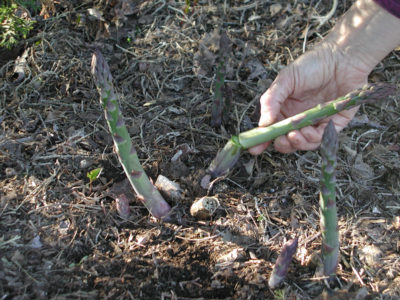 But the stalks of my asparagus are snapped off the plants within 100 feet of the kitchen door, clocking in at anywhere from a few minutes to an hour of time before they’re eaten. It’s not my green thumb that makes my asparagus taste so good. It’s the fact that I can harvest it within 100 feet of my kitchen door.
But the stalks of my asparagus are snapped off the plants within 100 feet of the kitchen door, clocking in at anywhere from a few minutes to an hour of time before they’re eaten. It’s not my green thumb that makes my asparagus taste so good. It’s the fact that I can harvest it within 100 feet of my kitchen door.
But don’t take my word for it. Research has shown that asparagus spears begin to age as soon as they’re picked, the stalks toughening and sugars disappearing, and bitterness, sourness, and off-flavors beginning to develop. Yum.
Taste is just one of the many reasons to plant asparagus. Here’s more: Deer and other wildlife leave it alone so it doesn’t need to be corralled within a fence; the ferny foliage that needs to be let grow after harvest ends in early July makes a soft green backdrop for colorful flowers; a planting can pump out stalks from the end of April till the end of June (around here) for decades.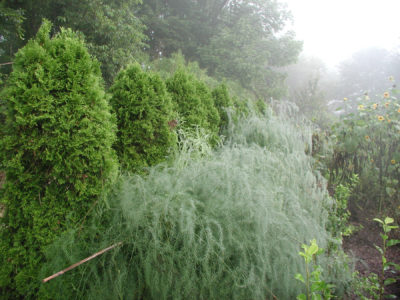
Asparagus’s two potential problems are relatively minor. The first is asparagus beetle, a beetle whose eggs, which look like black specks on the stalks, hatch into slug-like young that feed on the stalks. I keep this bugger in check by picking every single stalk — even spindly, inedible ones — every time the bed is harvested. The beetle, then, has nowhere to lay her eggs. (Not in my bed, least; she can seek out some wild asparagus here and there.) And then, at the end of the season, I cut down all the browned, ferny foliage and cart it over to the compost pile, in whose depths the adults, some of which overwinter in the old stalks, meet their demise.
No pesticides, organic or otherwise, have ever been sprayed on my asparagus, so natural predators also can do their share of making asparagus beetles a non-issue. Hand-picking beetles and larvae, which I’ve never had to resort to, is another way to keep the beetles in check. (My ducks may have a “hand” in that.)
Weeds are the other potential problem in an asparagus bed. One of the worst weeds in any bed is . . . asparagus! Each red berry dangling from the stems of a female asparagus plant houses a number of seeds that, once they hit ground level, can sprout to make new plants. The cure is to plant an all male variety of asparagus, such as Jersey Giant or Jersey Prince.
Unfortunately, a package of an all male variety can contain a few females. So, in addition to planting an all male variety, the cure for weeds is straightforward: Weed! I keep my bed regularly weeded during harvest season, then only occasionally weeded once fronds start to make the bed almost impenetrable.
Off With The Fruitlets (Some, At Least)
The slow but steadily increasing warmth this spring has been ideal for tree fruits (not so much the rainy weather). A bumper crop of fruitlets perch on branches of my apple and pear trees. It’s time to remove most of them.
These plants are genetically programmed to set more fruits than they could possibly have the energy to ripen. Spring presents many hazards to those blossoms, including killing freezes and insect pests. So, come June, when some of these threats have passed, fruit trees naturally shed excess developing fruitlets. But not enough.
The trees’ goals are to make seeds to make new trees. The seeds are enclosed within fruits that appeal to wildlife, who then help disperse the seeds. Those fruits might be good enough for wildlife, but not for you and me. For larger and more flavorful fruits, even more need to be removed than are shed by the “June drop.” Only 5 to 10 percent of apple blossoms need to set fruit for a full crop.
So I’m spending some time pinching or snipping off excess fruitlets, saving those that are largest and most free from blemishes, with a few inches between those that are left.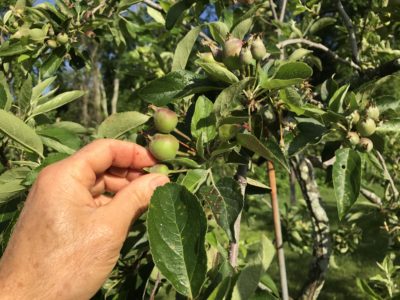
Fruit thinning is not only for flavor. A large crop one year bodes for a small crop the following; fruit thinning evens out any feast and famine cycle. The thinning also reduces some pest problems caused by fruits hanging too close to each other.
Pros And Cons Of Bad Weather (For Humans)
The recent spate of rainy weather has been accompanied by cool temperatures, which some plants enjoy and others wait out. Peas, cabbage, kale, and radishes are having a grand old time; sweet corn and beans wait out the cool weather. 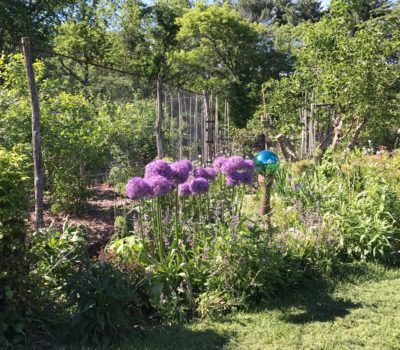 The most dramatic response has been in the delphiniums, dames rockets, and giant alliums. With cool temperatures, their colorful displays go on and on.
The most dramatic response has been in the delphiniums, dames rockets, and giant alliums. With cool temperatures, their colorful displays go on and on.
Asparagus doesn’t mind hot or cool weather. The cool weather does slow down spear production, which made for insufficient harvest to share the day my friends came to dinner.